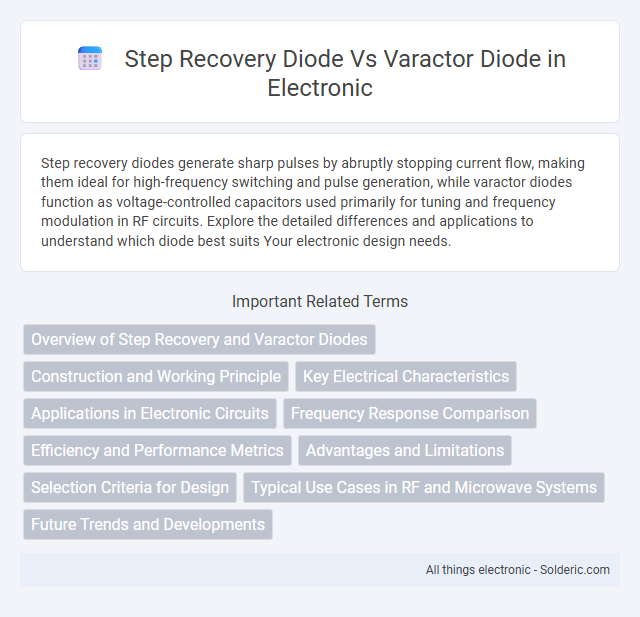Step recovery diodes generate sharp pulses by abruptly stopping current flow, making them ideal for high-frequency switching and pulse generation, while varactor diodes function as voltage-controlled capacitors used primarily for tuning and frequency modulation in RF circuits. Explore the detailed differences and applications to understand which diode best suits Your electronic design needs.
Comparison Table
| Feature | Step Recovery Diode (SRD) | Varactor Diode |
|---|---|---|
| Primary Function | Generate sharp pulses and harmonics | Tunable capacitance for voltage control |
| Operation Mode | Pulse generation and frequency multiplication | Voltage-dependent capacitance, used in tuning circuits |
| Capacitance | Fixed, minimal role | Variable, inversely proportional to reverse voltage |
| Applications | Pulse generators, frequency multipliers, harmonic generators | Voltage-controlled oscillators, tuners, filters |
| Switching Speed | Very fast recovery time (picoseconds to nanoseconds) | Moderate speed, not primarily for switching |
| Construction | Special doping profile for abrupt charge removal | PN junction diode with variable depletion region |
| Control Parameter | Current pulse triggering recovery | Reverse bias voltage |
| Output Signal | Sharp voltage pulses | Variable capacitance altering circuit frequency response |
Overview of Step Recovery and Varactor Diodes
Step recovery diodes are specialized semiconductor devices designed for pulse generation and frequency multiplication by rapidly switching from conductive to non-conductive states, producing sharp voltage transitions. Varactor diodes, also known as varicap diodes, function as voltage-controlled capacitors with a capacitance that varies according to the applied reverse bias voltage, essential for tuning and frequency modulation in RF circuits. The fundamental difference lies in the step recovery diode's ability to generate high-speed pulses versus the varactor diode's capacity for continuous capacitance tuning in voltage-controlled oscillators and phase-locked loops.
Construction and Working Principle
Step recovery diodes feature a PN junction designed to store charge during forward bias and release it abruptly when reverse biased, creating sharp voltage pulses ideal for high-frequency switching. Varactor diodes utilize a highly doped PN junction with a variable depletion region width that changes capacitance proportionally to the applied reverse bias voltage, enabling voltage-controlled tuning in RF circuits. The step recovery diode operates on charge storage and abrupt transition, while the varactor diode functions based on voltage-dependent capacitance modulation.
Key Electrical Characteristics
Step recovery diodes exhibit sharp transient switching due to their ability to store and suddenly release charge, featuring fast recovery times and high junction capacitance variation. Varactor diodes function primarily as voltage-controlled capacitors, with capacitance inversely proportional to the applied reverse bias voltage, making them ideal for frequency tuning applications. Your choice between these diodes depends on whether fast switching speed or precise capacitance control is critical for your circuit design.
Applications in Electronic Circuits
Step recovery diodes are primarily used in high-frequency pulse generators and harmonic multipliers, benefiting applications such as frequency synthesizers and ultra-wideband communication systems. Varactor diodes serve as voltage-controlled capacitors, widely applied in tuning circuits like voltage-controlled oscillators (VCOs), phase-locked loops (PLLs), and RF filters. Both diodes optimize frequency control, but step recovery diodes excel in pulse shaping while varactor diodes enable dynamic frequency tuning in electronic circuits.
Frequency Response Comparison
Step recovery diodes exhibit sharp transient responses ideal for generating high-frequency pulses and harmonics in microwave circuits, achieving frequency responses often exceeding tens of gigahertz. Varactor diodes provide smooth, voltage-controlled capacitance variation suited for continuous tuning in voltage-controlled oscillators (VCOs), typically operating efficiently up to a few gigahertz. The distinct frequency response capabilities stem from the step recovery diode's abrupt charge storage change versus the varactor's gradual capacitance modulation.
Efficiency and Performance Metrics
Step recovery diodes excel in high-speed switching applications due to their rapid charge snap-off characteristics, offering superior efficiency in pulse generation and frequency multiplication. Varactor diodes provide voltage-controlled capacitance, enabling tunable performance in oscillators and voltage-controlled oscillators (VCOs), but typically exhibit slower response times and higher losses compared to step recovery diodes. Your choice depends on whether high-frequency, efficient pulse shaping (step recovery diode) or adjustable capacitance for frequency tuning (varactor diode) is the primary performance metric needed.
Advantages and Limitations
Step recovery diodes provide fast switching and sharp pulse generation, making them ideal for high-frequency applications, but they may suffer from limited power handling and increased circuit complexity. Varactor diodes offer voltage-controlled capacitance with low noise and easy tuning, benefiting voltage-controlled oscillators and tunable filters, though their performance can degrade at higher frequencies and under high power conditions. Your choice depends on balancing speed, tuning range, and power requirements for optimal circuit design.
Selection Criteria for Design
Step recovery diodes are selected for designs requiring fast switching and high-frequency pulse generation due to their ability to produce sharp transitions and short pulses. Varactor diodes are preferred when voltage-dependent capacitance for tuning and frequency modulation is needed, leveraging their variable capacitance characteristic under different bias voltages. Design selection hinges on whether the application demands rapid pulse shaping (step recovery diode) or tunable reactive components (varactor diode) for circuit performance optimization.
Typical Use Cases in RF and Microwave Systems
Step recovery diodes are typically used in RF and microwave systems for generating sharp pulses and high-frequency harmonics, making them ideal for frequency multipliers and pulse generators. Varactor diodes serve primarily as voltage-controlled capacitors, enabling tunable filters, voltage-controlled oscillators (VCOs), and phase shifters in RF circuits. Your choice depends on whether you need efficient harmonic generation or voltage-dependent capacitance for tuning and frequency control.
Future Trends and Developments
Step recovery diodes and varactor diodes are evolving with advancements in semiconductor materials such as GaN and SiC, enabling higher frequency and power handling capabilities. Future trends emphasize integration into compact, high-performance RF and microwave circuits for 5G and beyond, enhancing signal tuning and pulse shaping efficiency. Your ability to leverage these improvements will drive innovations in wireless communication and radar systems.
Step recovery diode vs varactor diode Infographic

 solderic.com
solderic.com